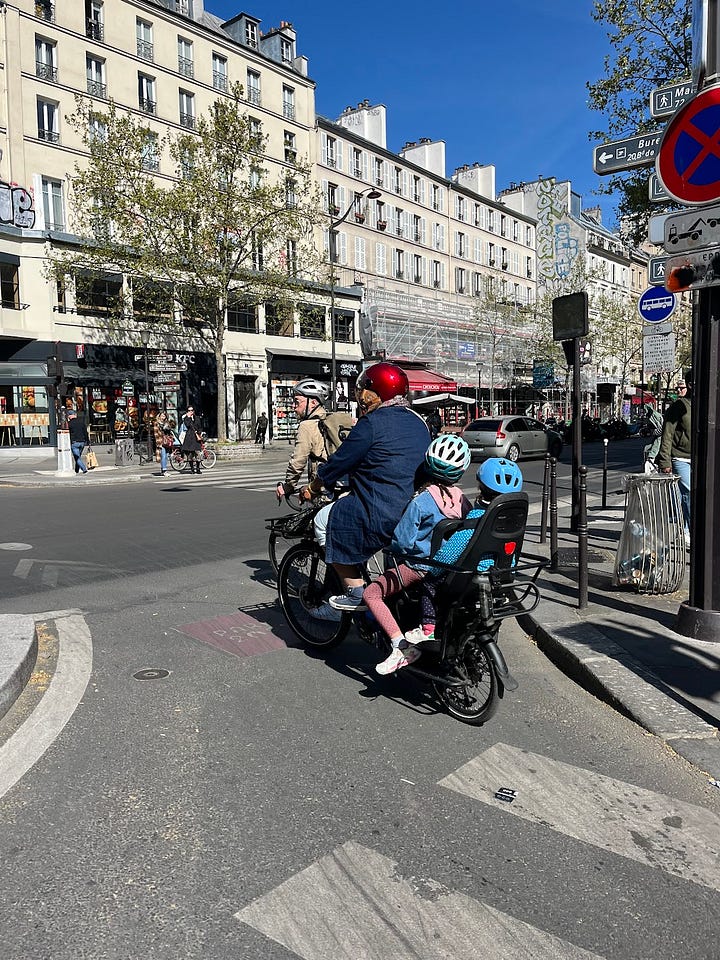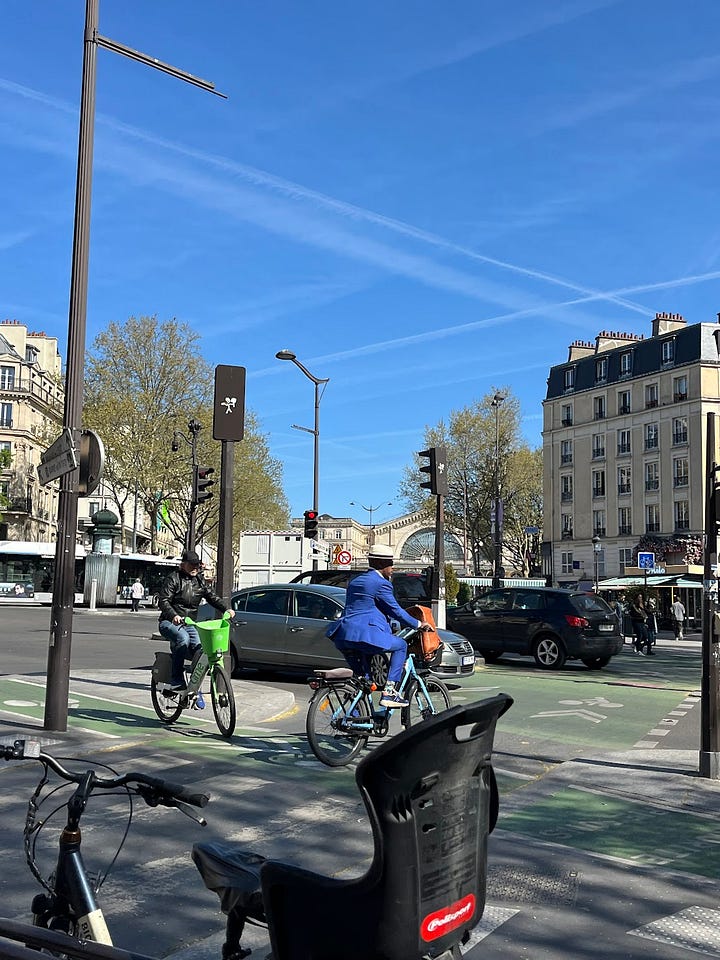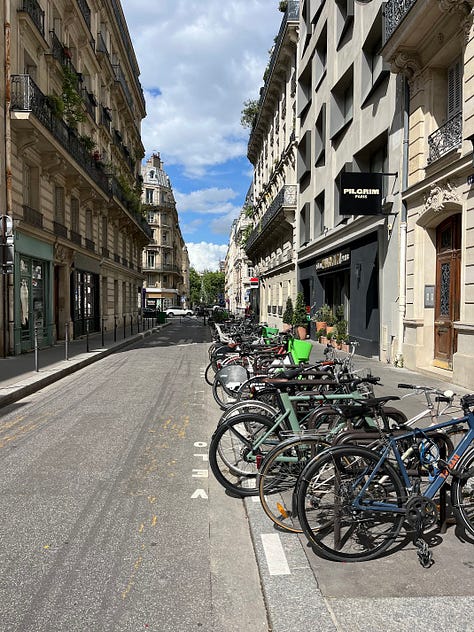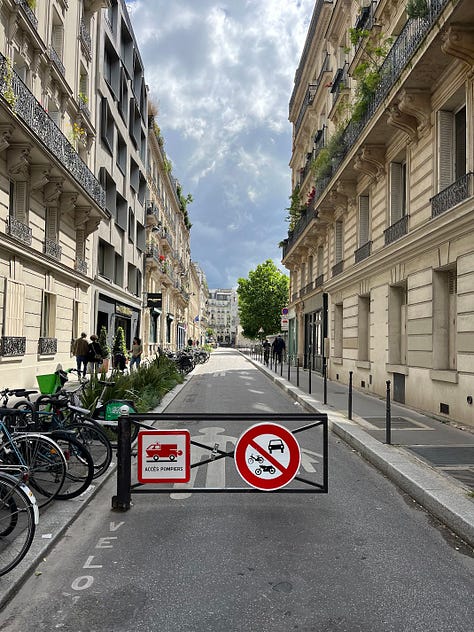Reclaiming the City: Paris’s Decade-long Ride Towards a More Liveable Future
Analysis of a City Transformation | Paris, France
In this article, we explore the factors that informed Paris’s remarkable urban transformation over the past decade: policies to foster socially connected and functionally mixed neighborhoods; the reclamation of former expressways into people-friendly greenways; the enactment of a pioneering zoning plan which explicitly embeds climate goals into urban planning; and the role of the 2024 Olympics as a catalyst for accelerating cycling infrastructure and culture.


A bit of background…
Over the past decade, Paris has undergone a series of bold urban transformations to enhance liveability and mitigate the effects of climate change. The French capital is adapting to meet the challenges of a contemporary metropolis, reclaiming public space from cars to reintroduce a human dimension to the city. These efforts took off in 2001, as Paris Mayor Bertrand Delanoë initiated a series of progressive social and environmental reforms. These reforms included the creation of bus lanes across much of the city, the launch of the world’s first major bike-share program –“Vélib’”– to tackle car dependency, and the establishment of the city’s first Climate Action Plan in 2007. Despite initial setbacks, including concerns over cyclist safety due to the lack of appropriate infrastructure (please refer to figure 6) and technical problems, the Vélib’ bike-sharing system is gaining popularity among Parisians. Beginning with a fleet of 10,000 bicycles, it has since expanded to 20.000 bicycles, distributed across 1.480 docking stations throughout Paris and 65 surrounding municipalities. This made it the largest bike-sharing system from the end of 2024, increasing the accessibility of cycling citywide.
However, it was the election of mayor Anne Hidalgo in 2014 that fundamentally changed the direction of neighborhood and street life planning in Paris. Under the mayor’s tenure, Paris has ushered in a new era, prioritizing vibrant, sustainable, healthy urban life through the development of accessible, mixed use neighborhoods. Today, Paris is proof that large, international cities need not be stuck in their ways. Transformation that enhances liveability, and addresses contemporary challenges, is possible when vision meets political willingness.
The heartbeat of a city, in 15 minutes
Driven by social and environmental concerns, the progressive mayor put the 15-minute city concept–first coined by Professor Carlos Moreno, an urbanist and professor at the Sorbonne Business School in Paris–at the heart of her vision, earning Paris its reputation as a leading example of the concept globally. The 15-minute city is grounded in the notion that all essential services, such as schools, workplaces, shops, healthcare, and leisure, should be accessible within a 15-minute walk or bike ride anywhere in the city. It emphasizes local living, reduced reliance on cars, and improved public health through enhanced walkability, lower air and noise pollution, and the creation of socially and economically vibrant neighborhoods. The concept promotes the idea that neighborhoods must be socially connected and functionally mixed, and centered around human scale designs to encourage active mobility. Hidalgo’s vision of a compact, walkable Paris directly informs the city’s broader urban mobility strategy, including ambitious road redesigns that reclaim space from cars and transform previously car-dominated areas into vibrant, pedestrian- and cyclist-friendly urban spaces.
From expressways to people-friendly greenways
Paris has made significant efforts in reshaping its urban mobility landscape by reclaiming car-dominated infrastructure for people and the environment. One of the most emblematic examples of this shift was the transformation of the Seine’s expressways into car-free leisure zones. The definitive ban on cars along the Left Bank in 2013, followed by the Right Bank in 2017, marked the transformation of the riverside expressways as leisure spaces.

The bankside closure was originally intended as a pilot project to assess the impact on traffic flow, pedestrian safety, and urban livability. In October 2018, the Administrative Court of Paris declared that to preserve the Seine riverbanks, a UNESCO World Heritage site since 1991, the bankside closures would become permanent, creating a new riverside to be enjoyed safely by everyone. One year into the pedestrianization, pollution levels had already dropped by a significant 25% on the right bank of the Seine.

Alongside riverside regeneration, the city has taken decisive steps to curb traffic on the Boulevard Périphérique, the city’s ring road. The idea is for this asphalt motorway to be partially transformed into a “green belt” (in French, ceinture verte) by 2030. The transformation, which launched during the Olympics in 2024, kicked off with a decrease in the speed limit to 50 km/h to reduce pollution and improve safety. In March 2025, a dedicated lane for carpooling, buses, and taxis was introduced. Its evaluation is set for September and December 2025, with a follow-up assessment in March 2026. For the ringroad to earn its title as a green belt, the reclaimed lanes and surrounding infrastructure (amounting to 10 hectares of roadway) will become green hotspots, through the planting of an additional 20,000 trees. This project is celebrated as a shift from a “grey belt” of pollution and congestion to a more enjoyable, dynamic and green urban corridor benefiting multimodal users.

A zoning transformation built on climate goals
Zoning has become a key mechanism in advancing Paris’s vision of proximity, diversity, density, and ubiquity. In November 2024, Paris adopted a new zoning framework, the Plan Local d'Urbanisme bioclimatique (PLUb) - the bioclimatic local urbanism plan. This plan replaced the 2006 plan and redefined building and development rules for the next 15 years, making climate objectives central to land-use policy. A key goal is achieving carbon neutrality by 2050 and ensuring 10 m² of green space per inhabitant. In Hidalgo’s words, the plan is meant to maintain the attractiveness of the capital city in the coming years despite rising temperatures. The PLUb explicitly states that actions to address the climate crisis and housing needs must align with the “15-minute city” model. Key initiatives of the plan include:
Mixed-use neighborhoods: Office development projects greater than 5000 m² must have 10% of surface area dedicated for housing.
Social diversity of housing: 50% of each housing project must be dedicated to social housing, with the goal of achieving at least 40% of social housing by 2035.
Greening: Development of an extra 55 hectares of green spaces to achieve 10 m² of green space per inhabitant by 2050.
Local public services and entertainment: More than 100 sites earmarked for health, sporting, and cultural facilities.
Support for local businesses, and enhanced protection of commercial frontage: A total of 329 km of protected commercial frontages, 29 km for artisanal businesses and 9 km for cultural businesses.
Recreational opportunities: Creation of a green and sports belt around the ring road in working-class neighborhoods.
School streets: Transformation of more than 200 school streets featuring widened pedestrian areas, restricted car access during school hours, added greenery, and child-friendly urban furniture to create welcoming environments around schools. Complementary to school street greening, as part of the city’s climate plan, an additional 360 “Oasis” schoolyards will come to life by 2030, serving as pockets of biodiversity, cooling refuges during heat waves, and learning labs for children.



Cycling infrastructure: Doubling of surface area required for bike parking in new buildings, in line with the city’s bicycle plan.
Cycling infrastructure meets the moment
Under the leadership of Mayor Anne Hidalgo, Paris has been advancing its cycling agenda through a series of ambitious bicycle plans. The first Bicycle Plan (2015-2020) invested €150 million in cycling infrastructure and improvements with the goal of making Paris a 100% cyclable city. In 2020, Paris unrolled 52 kilometres of pop-up bike lanes, later made permanent. One significant example was the conversion of Rue de Rivoli, one of the busiest roads, into a cycling highway. The same year, Hidalgo announced her plan to remove thousands of on-street parking spaces by 2026 to free up space for bike lanes, green spaces, and urban furniture. Approximately 10.000 parking spots have already been removed in the past five years, and voters approved the removal of an extra 10.000 spaces in a public consultation in March 2025.
Ultimately, bike lane development efforts piloted in 2020 laid the groundwork for the 2021–2026 Bicycle Plan, which mobilized a €250 million investment to expand cycling infrastructure, roll out large-scale secure bicycle parking, and strengthen the cycling ecosystem across Paris and the greater metropolitan area to promote regional integration.
Building on this trajectory, Paris leveraged the 2024 Olympics as a strategic opportunity to test new street designs and promote everyday cycling among both residents and visitors. Hosting the first 100% cycleable Olympic Games had long been a priority objective on the city’s agenda. The state worked together with local authorities to build an additional 120 km of cycle paths, completing a total of 400 km across the Île-de-France region. Road infrastructure developments in the city were accompanied by a large-scale deployment of secure parking spots in the two years leading up to the Olympics. This included a €4.4 million government investment in 3,200 spaces at Paris train stations, as well as €2 million to support the creation of an extra 27,000 bicycle parking spaces near all Olympic venues. Additionally, an extra 3000 Vélib bikes were put into service. The success of the investments are apparent in the numbers - 10,000 spectators cycled to Olympic Games venues each day.

One remarkable long term outcome of the games is the ongoing surge in cycling uptake since 2024, when cycling overtook car usage in the city centre. Today, about 11.2% of trips in the city are made by bike, compared to just 4.3% by car - a drastic pedal forward from 2010 when only 3% of trips were taken by bicycle.
Conclusion
Paris stands as a global model of urban resilience, where proximity, sustainability, and mobility blend to create greener, healthier, and more inclusive public spaces for all. Over the past decade, the city has been the theatre of a series of bold urban interventions - from the expansion of the Vélib’ bike-share system to the radical pedestrianization of the strategic axis, to the introduction of progressive zoning and land-use policies. The 2024 Olympics was evidence of the need for, and the benefits of, traffic-calmed streets where cyclists and pedestrians can mingle, away from the noise and pollution of cars. Cycling overtaking cars in modern share was a clear, low-hanging fruit.
It is safe to say that while Mayor Hidalgo’s bold plans, financial investments, and political commitment have undeniably steered Paris towards becoming a cycling city through a largely top-down transformation, the rise in cycling has also been fostered by grassroots social movements and their dynamic interplay with policy-making. To understand the full picture, check out our article “Transforming Paris from Below: Cycling as a Social Movement”, which delves into how activists, and local communities in Paris have reshaped the city’s streets. Cycling is not just a policy goal, but a lived, collective experience.
Written by
(Researcher) and edited by (Intern) of Urban Cycling Institute.Interested in writing or sponsoring an article? Send us a pitch at media@urbancyclinginstitute.org








I had read much about how great Hildago was and how so many more people in Paris were cycling. But when I went there last year cycle lanes were poorly used and a lot rarer than I would have thought before my visit. We were there 3 weeks and I never felt like getting on a bike to get around despite having just spent time in Blankanese in Hamburg where cycle infrastructure was also poor but it felt safer to jump on a bike. Before that I had 3 weeks in Amsterdam mostly on a bike. Paris is no Amsterdam, not even close.